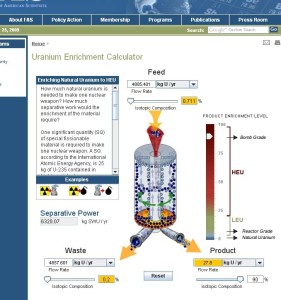Calculating Output of the New Iranian Uranium Enrichment Plant
On Friday, President Obama announced that the United States knows of a new, undeclared, and hidden underground gas-centrifuge uranium enrichment facility in Iran, near the city of Qom. Some news reports suggest that 3000 centrifuges will be housed there. How significant is this discovery? Well, just in time, our crack FAS researcher, Ivanka Barzashka, has posted on the FAS website a calculator to help you answer questions just like that.
Natural uranium is made up predominantly of two isotopes, that is, atoms of the same element with the same chemical properties but very slightly different masses and, therefore, dramatically different nuclear properties. Uranium-235 is the isotope that powers nuclear reactors and nuclear bombs. Natural uranium is less than one percent 235 but approximately 90 percent U-235 is needed for a bomb. Getting these higher concentrations is called “enrichment”. Today gas centrifuges are the method of choice for enriching uranium. Hence the great concern about the latest revelation. [We have a nice little video that explains how centrifuges work.]
The calculator can be used to investigate possible Iranian breakout scenarios. In summary, the user has to supply the calculator with the concentration of uranium-235 in the input, or feed. Natural uranium is 0.7%. If the Iranians used the output of the enrichment plant at Natanz as input to the Qom plant, then they could start with 3.5%. The user must also specify the U-235 concentration in the waste. If Iran wants to get as much U-235 as possible out of its uranium supply, then this number will be small, usually 0.2-0.25%. If Iran is in a rush, it could feed uranium through faster but throw away more U-235. For example, if it used 3.5% as input, it could have “waste” of 1%, which is a higher U-235 concentration than natural uranium.
The calculator then returns the value of amounts of uranium and the “separative work” needed. Separative work is a general measure of the capacity of an enrichment element (such as a centrifuge or centrifuge plant) to enrich a certain amount of material over a given time. A plant operator can utilize any given plant capacity to enrich a large amount of uranium a little bit (as you would for a nuclear reactor) or to enrich a small amount of uranium a lot (as you would for a nuclear bomb). It is as though we had a pump of a certain power available and we could choose to pump a large volume of water a small distance uphill or a small quantity of water much further uphill. Separative work is measured in Separative Work Units or SWUs, performed on a certain amount of material, almost always kilograms, so the unit is kg-SWU.
How many SWUs would the enrichment plant at Qom have and what could the Iranians do with it? First, keep in mind that all information we currently have on the new facility is pretty vague and based on a few news reports. Iran has not officially declared the capacity of the Qom plant or what kind of machines it will contain. But it was reported to have 3000 centrifuges. Very simple calculations based on IAEA reports suggest that the first generation Iranian centrifuges produce approximately 0.5 kg-SWU/year so the plant would produce 1500 kg-SWU/year. Perhaps the second generation centrifuges would go in the new facility. We really know very little at all about these except that they are presumably better than the first generation. You can speculate on the separative work of these centrifuges and multiply by 3000.
Using some of the examples above, we can use the calculator to estimate the bomb-making potential of the new Iranian facility. For example, if we start with natural uranium and calculate how many SWUs are needed to produce on bomb’s worth of 90% U-235 (estimated to be 27.8 kg for the simplest bomb, significantly less for a more sophisticated bomb), we find that 6400 SWUs are required or over four year’s worth of production at 1500 SWU a year. If we start with 3.5% U-235 from the Natanz plant and have wastes of 1%, then we need 1328 SWUs, so a 1500 SWU plant could produce a bomb’s worth in a little less than a year. Of course, if the individual centrifuges are higher performance, these times are reduced proportionately. We don’t know enough about the new facility to say much more than that.
The calculator was developed by an interdisciplinary team with background including scientists and programmers. The calculator is geared toward people without a technical background. The programming was done predominantly by FAS intern Augustine Sebastionelli, a computer systems major at Alvernia University. The technical aspect of the project was managed by Greg Watson, IT manager at FAS and, when Greg left FAS to return to get his master’s degree in political science, finished by our new IT Manager, Robert Lilly. FAS intern Amit Talapatra, a chemical engineering major from the University of Virginia, worked with the programmers to develop an algorithm to perform the dynamic calculation. Overall coordination and concept design was Ivanka Barzashka’s.
The FY2026 National Defense Authorization Act (NDAA) paints a picture of a Congress that is working to both protect and accelerate nuclear modernization programs while simultaneously lacking trust in the Pentagon and the Department of Energy to execute them.
While advanced Chinese language proficiency and cultural familiarity remain irreplaceable skills, they are neither necessary nor sufficient for successful open-source analysis on China’s nuclear forces.
Satellite imagery has long served as a tool for observing on-the-ground activity worldwide, and offers especially valuable insights into the operation, development, and physical features related to nuclear technology.
This report outlines a framework relying on “Cooperative Technical Means” for effective arms control verification based on remote sensing, avoiding on-site inspections but maintaining a level of transparency that allows for immediate detection of changes in nuclear posture or a significant build-up above agreed limits.
